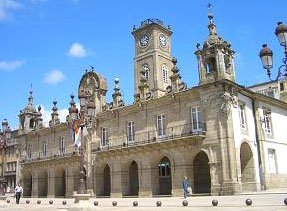Lugo's Civil and religious buildings
Religious icons of Lugo
Being in possession of one of Galicia's five cathedrals is undoubtedly the high point of Lugo's ecclesiastical heritage. But both town and region have many churches, monasteries and convents that are also worthy of mention and some of these lie within the walled city.
Convento de San Francisco
The "Convento de San Francisco", which today acts as the provincial museum, is of
 Gothic design with a medieval 15th century cloister. It houses a collection of paintings, folk history, ceramics, coins, clocks and also some gold relics found at local Castros (Celtic fort settlements). The convent was converted into a museum in 1957 and has been protected since 1931, although it was extended in 1990. The convent has a church connected to it. (Photo above reproduced from Lugo's Xunta produced tourist guide.)
Gothic design with a medieval 15th century cloister. It houses a collection of paintings, folk history, ceramics, coins, clocks and also some gold relics found at local Castros (Celtic fort settlements). The convent was converted into a museum in 1957 and has been protected since 1931, although it was extended in 1990. The convent has a church connected to it. (Photo above reproduced from Lugo's Xunta produced tourist guide.)
Capilla de San Roque
Situated a short distance from the boundary of Lugo's walled city in the oldest quarter of
 outer Lugo is the "Capilla de San Roque". This church was built in the eighteenth century and designed by "Ferro Caaveiro" in the Baroque style. Its origins have connections with the plague and a ceremony takes place each August (16) to commemorate this fact. The building is far from spectacular to look at and it is certainly not monumental in size, but it does possess a carving of "San Roque" (by Francisco Xavier Meana) that sits above the altar.
outer Lugo is the "Capilla de San Roque". This church was built in the eighteenth century and designed by "Ferro Caaveiro" in the Baroque style. Its origins have connections with the plague and a ceremony takes place each August (16) to commemorate this fact. The building is far from spectacular to look at and it is certainly not monumental in size, but it does possess a carving of "San Roque" (by Francisco Xavier Meana) that sits above the altar.
Capilla del Carmen
The "Capilla del Carmen" is on the site of an old Roman road which was once part of the pilgrims "Camino" to Santiago and lies just outside the town walls.
The building takes its name from the "Carmen" gate that takes you into and out of the walled town and has held this name since a dedication in 1773. The church is built of granite and has a Baroque facade and tower featuring a helmet and shield along with an arched portico. Inside you will see an image from the sixteenth century of "Carmen".
Civic structures

Lugo really does have a wealth of, if not monumental, none the less aesthetically pleasing buildings in its capitol. These building are not just confined to the walled city, but extend out beyond the Roman enclave and include University buildings, council and government offices and all manor of business premises. Exiting the walled town from the Santiago gate is a good starting point from which to explore these outer areas. The image above is of a building that appears strangely out of place just beyond the perimeter of the town's Roman wall.
A walk in the ancient walled district will however display Lugo's architectural heritage to the fore. Here you will see not only see the traditional granite and white render of Galician construction, but also brightly painted facades in yellow and green that are uncommon else where.

Lugo's streets appear wide and on a sunny day the colonnaded effect you will experience in other Galician towns is, for a change, pleasantly absent. Most of the inner city's impressive buildings are located on, or close to, one of Lugo's plazas, so the "Maior" and "Soedade/Domingo" squares are good starting points from which to explore.
The scale of buildings in Lugo is certainly less grand than in some of Galicia's other cities, but the detailing and town planning ensure that there is still plenty to see.
The "Palacio Episcopal" (photo at the foot of the Lugo cathedral page), is the house of the Bishop and sits behind the cathedral in a small piazza.
The "Casa Consistoria" (photo left) is on the main square and has a regal appearance, whilst the government office's building (Palacio de San Marcos) can be found to the east in the walled old quarter.
Lugo's Roman bridge

A short distance from Lugo's spa is a stone bridge that spans the river Mino and some parts of this structure also date from the Roman period. Both spa and bridge require a car or taxi journey from Lugo town due to their depressed elevation in the valley below the city.
Back to Lugo general page.
Return to Galicia Spain main page.

